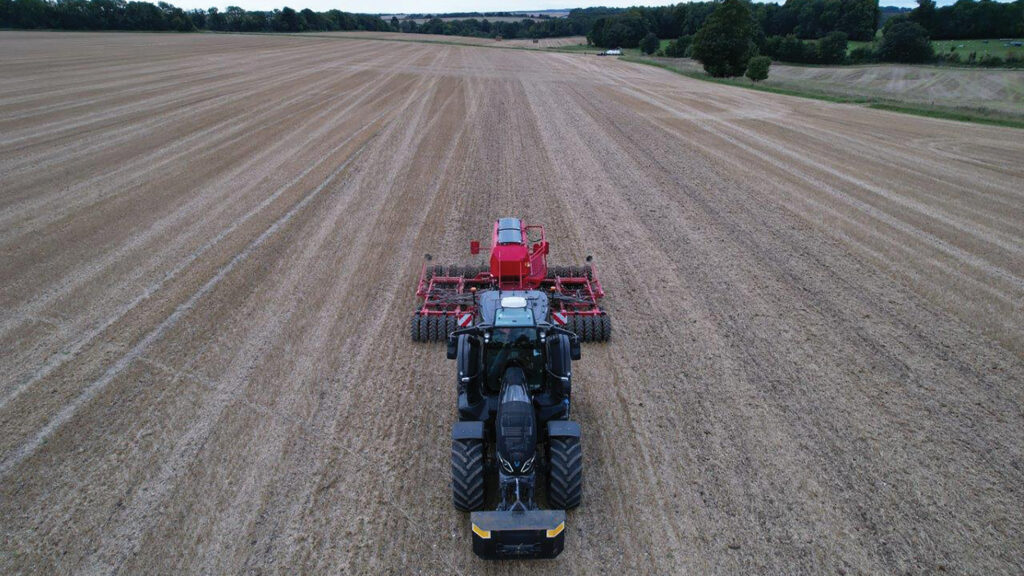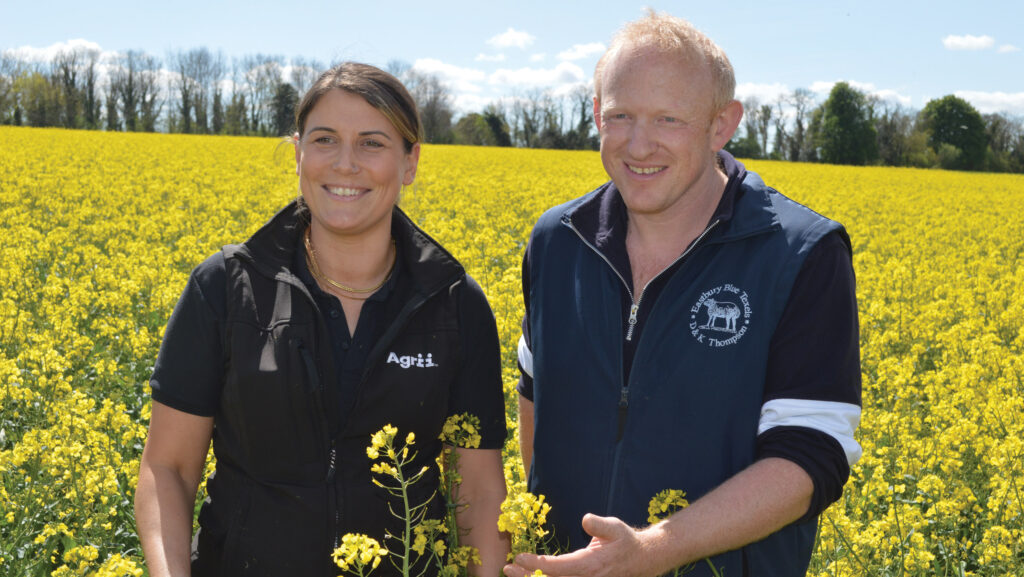Dorset grower gains from six-point oilseed rape plan
 © David Jones
© David Jones Dorset farmer David Thompson’s six-point plan for oilseed rape establishment has led to near-4t/ha yields over the last five years, and will allow him to qualify for £200/ha of environmental aid.
In a season when the UK rapeseed area has fallen sharply and many crops have suffered from pest damage and winter waterlogging, his early-flowering crop looks promising on his farm’s chalky downland soils.
David’s programme has seen his five-year rapeseed yields range from 3.7 to 4.2t/ha with few crop failures. Importantly, he has escaped the worst of the potential damage from the ubiquitous cabbage stem flea beetle.
See also: How YEN prize winners have achieved impressive OSR yields
The programme includes:
- Leaving long cereal stubbles
- Minimising soil disturbance
- Using a companion crop
- Avoiding early drilling
- Using a hybrid variety
- Applying seed-bed fertiliser.
Profitable break crop
Oilseed rape is seen as the most profitable break crop on the farm, so David is keen to keep it in the rotation. It also has the beneficial role of controlling grassweeds.
“The six-point plan has been key to good establishment and good yields, and if crops yield above 3.5t/ha we will stick with oilseed rape,” he says.
As arable manager at Eastbury Estates, he grows 100ha of oilseed rape both on-farm and contracted land in a five/six year rotation.
Together with spring beans, they are the only break crops on the estate, which grows winter wheat, winter barley and spring barley.
Despite David’s success, flea beetles remain a constant concern on the 400ha farm at Tarrant Gunville, north-east of Blandford Forum, while the estate has just suffered its worst autumn infestation of slugs in living memory on rain-soaked soils.
Deterring pests
Oilseed rape usually follows winter wheat or spring barley on the farm so a long 100-150cm stubble is left to help deter flea beetles.
All straw is baled – the absence of chopped straw helps limit slug damage in a “normal” season.
There is an emphasis on low soil disturbance to deter flea beetles as they are often attracted to bare and freshly moved soil.
So treatments such as straw rakes or minimum cultivations are not used, and low soil disturbance drills are favoured.
A companion crop is drilled soon after harvest, ideally 10-15 August, to give at least 10-14 days for the buckwheat to grow before the oilseed rape is sown.
“We need this buckwheat canopy before the oilseed rape emerges,” says David.
The success of the companion crop means the farm has not applied a pyrethroid insecticide to control flea beetles for a number of years.
The buckwheat is drilled at a seed rate of 10kg/ha with a low-disturbance disc drill – a Moore Unidrill.
Last summer, one field was drilled with a buckwheat/vetch/fenugreek mixture which appeared to be an even better deterrent to flea beetles and birds, so an expanded area will be tried next season.
Crop establishment
David aims for an OSR drill date around 20-25 August in this area of southern Dorset, with the crop emerging seven days later under a carpet of buckwheat, and so hidden from marauding flea beetles at the peak of their migration around August bank holiday.
Drilling too early in the first half of August can mean the rapeseed crop grows to be knee-high in November, and the larvae from the feeding flea beetles can decimate crops by January and February.
However, drilling later into September can mean slugs become an even greater problem. David aims to give the oilseed rape a good start as the farm has a game bird shoot, meaning crops can suffer from pheasant and partridge grazing.
The policy on the farm has been to use fast-growing vigorous hybrid oilseed rape varieties over the past five years, starting with InV1035 and moving to ExSteel from Bayer’s Dekalb breeding programme.
“This hybrid gets away quickly in the autumn and has yielded better than other varieties and last year averaged 3.8t/ha,” says David.
The rapeseed crop is direct-drilled with the farm’s Horsch Sprinter 6m tine drill with Dutch openers which has worked well, but he adds that ideally he would like to move to a Horsch disc drill.
This would mean using disc drills for both the companion crop and rapeseed, and would see even less soil movement.
David points out that initially they used a tine drill to establish the buckwheat and there was a struggle to control flea beetles, but the move to disc drilling and low soil movement has helped in the battle.
The drilling rate is fairly standard for a hybrid variety at 50 seeds/sq m, aimed to give a plant population of 25-30/sq m in the spring.
Fertiliser in the seedbed, applied at drilling time, is key for good establishment and diammonium phosphate (DAP) is used to give the crop the best possible start.
Cutting costs
Variable costs for the crop on the farm have been trimmed back in the autumn with no use of pre-emergence herbicides, and agrochemical costs amount to £115/ha up to Christmas this season.
These include three applications of slug pellets (£45/ha), post-emergence herbicide clethodim (£20/ha) to control grassweeds and volunteer cereals, followed by herbicide propyzamide as Kerb (£30/ha), and a prothioconazole/tebuconazole fungicide treatment for phoma/light leaf spot at £20/ha.
Other variable costs include the hybrid rapeseed at £85/ha, buckwheat at £12/ha and DAP fertiliser at £40/ha to give total variable costs of £252/ha before the end of the year.
Some of this cost can be offset by new Sustainable Farming Incentive (SFI) measures, with direct-drilling earning £73/ha, precision fertiliser application £27/ha, companion cropping £55/ha and the non-use of insecticides £45/ha.
“We are already doing these measures so this is a bonus, while we have not applied an insecticide for six-to-seven years when growing oilseed rape,” says David.
SFI measures which could be utilised when growing oilseed rape
The six-point programme opens up the possibility of payments under the Sustainable Farming Incentive (SFI) scheme for direct drilling, using variable-rate fertiliser, companion cropping use and not using insecticides.
This is allowing David to qualify for £200/ha of payment.
2024 SFI soil and precision farming actions
- No-till farming (£73/ha)
- Variable-rate application of nutrients (£27/ha)
SFI actions for integrated pest management
- IPM3: Companion crop on arable land (£55/ha)
- IPM4: No use of insecticide on arable crops (£45/ha)
Agronomist view on hybrid variety ExSteel

Jazz Jex and David Thompson © David Jones
Jazz Jex, agronomist and local trials co-ordinator with advisory group Agrii, says the hybrid variety ExSteel has performed well in company trials over a number of years in terms of speed of autumn/winter development.
“The variety has come out top in our trials since 2017 in terms of autumn establishment from October through to January, and the gap has been more significant in difficult years,” says Jazz, sister of fellow Agrii agronomist Todd Jex who was winner of the Farmers Weekly Arable Adviser of the Year award in 2023.
In the group’s trials, the variety has come out just above popular hybrid varieties, such as Auckland and Ambassador, in terms of autumn development, while conventional varieties such as Turing and Amarone have not performed as well as hybrids.
Jazz has been using drones to assess the vigour of the oilseed rape through the autumn and winter, and the drone’s imagery is able to take out the buckwheat to give a clear view of the rapeseed’s development.

